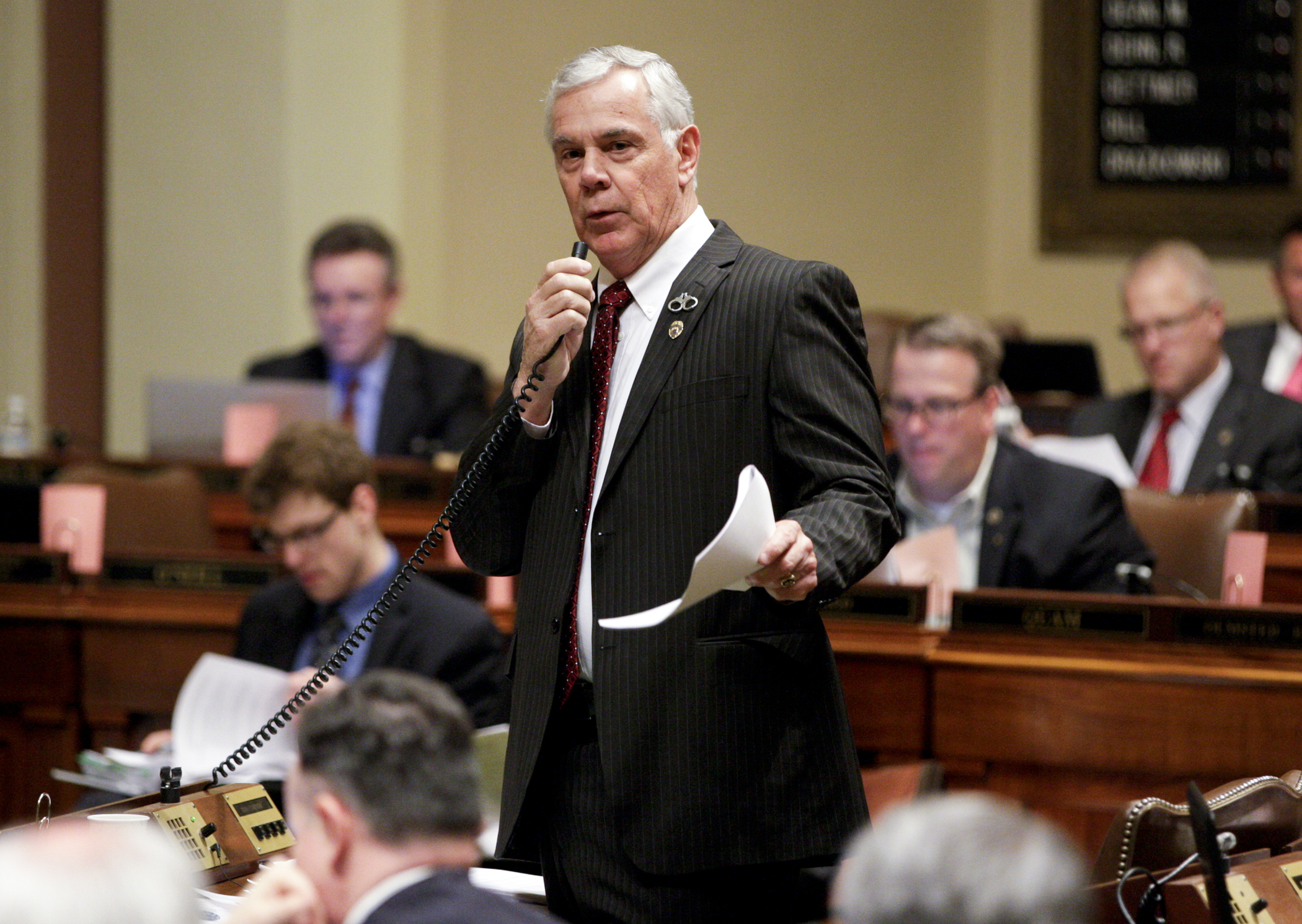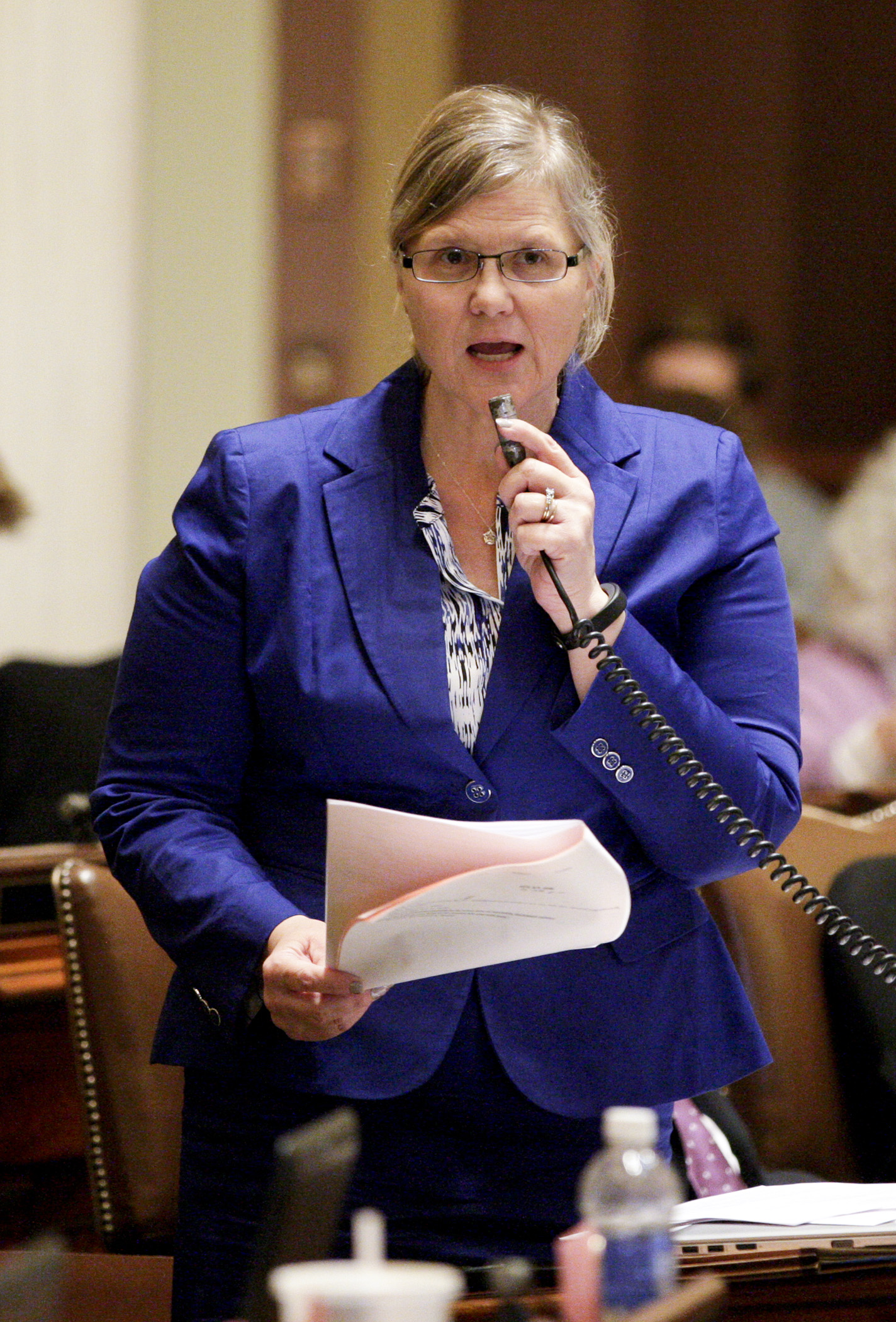Omnibus public safety finance and policy bill gets House OK; heads back to Senate

Standing on the House Floor with a handcuffs lapel pin on his suit jacket, Rep. Tony Cornish (R-Vernon Center) called the omnibus public safety finance and policy bill “pretty bipartisan.”
Most House members agreed.
Sponsored by Cornish, HF849/SF878*, as amended to include the House language, contains a little over $2.08 billion in spending — nearly all of it from the General Fund.
Following the 115-19 vote, the bill returns to the Senate for concurrence. A conference committee is expected to work out the differences. Sen. Ron Latz (DFL-St. Louis Park) is the Senate sponsor.
“We put together a fairly non-controversial bill,” Cornish said. “The only controversy really you’ll find in this bill probably is the amount of money we put into to each category.”
“The only thing that’s wrong with this bill at all is what’s not in it, and that isn’t Rep. Cornish’s fault, that’s the target that he was given. He did a lot with what he had; however, there were many, many things that, unfortunately, we were not able to do.” said Rep. Debra Hilstrom (DFL-Brooklyn Center). “There’s a lot of really good policy that was added to the bill. … No matter what issue you’re passionate about, I think you can find some good things in this bill and I think you can find some things in the bill you might not just be satisfied with.”
As it now stands, the bill would spend almost $64.9 million less than what is proposed by Gov. Mark Dayton, in part from spending less for judicial branch employees.
 Rep. Debra Hilstrom speaks on an amendment to the omnibus public safety finance and policy bill HF849/SF878*, during debate on the House Floor April 28. Photo by Paul Battaglia
Rep. Debra Hilstrom speaks on an amendment to the omnibus public safety finance and policy bill HF849/SF878*, during debate on the House Floor April 28. Photo by Paul BattagliaMORE: View the spreadsheet
For example, the governor requested 5 percent in each year for Supreme Court and trial court employees and judges; the bill calls for 1.5 percent salary increases each year and additional money for insurance increases. The House bill does not contain requested increases in juror mileage rate and per diems.
Additionally, the House would spend approximately $15 million less on corrections than the governor. More than $5.1 million of that would come from not switching kitchen workers at several facilities from contract employees to state employees. Also not funded was a Dayton request to fund 19 new positions to provide 24-hour nursing coverage at three additional facilities.
Specific funding includes:
- nearly $6.9 million, including an additional $1.85 million offered through an amendment, to the Bureau of Criminal Apprehension to, in part, replace forensic laboratory equipment and hire 13 people to increase the capabilities of the predatory crimes section, hire nine people to form a digital forensics examination unit, hire five people to form a financial crimes unit, hire two more latent fingerprint examiners and hire one more mitochondrial DNA position;
- $948,000 each year to improve access of low-income clients to legal representation in family law matters;
- $250,000 in Fiscal Year 2016 “to develop strategies to combat the recruitment of Minnesota residents by terrorist organizations such as ISIS and al-Shabaab”;
- $250,000 in each year to support new or existing multi-jurisdictional entities to investigate sex trafficking crimes and provide training to law enforcement agencies across the state;
- $100,000 each year for training state and local community safety personnel in crisis de-escalation techniques;
- $50,000 each year to establish a lifesaver grant program to help make it easier to find vulnerable people who have wandered off;
- $50,000 each year to expand specialty courts; and
- $50,000 each year for grants to existing child advocacy centers whose primary purpose is to coordinate the investigation, treatment and management of abuse cases and to provide direct services to abuse victims.
Amendments added
The House added some policy amendments to the bill, including:
- establishment of a Blue Alert system — similar to the Amber Alert system — to aid in finding people suspected of killing or seriously wounding a law enforcement officer;
- clarifies that a person who conceives a child through sexual assault or rape should not have parental rights or their should at least be a legal mechanism for doing so; and
- someone who impersonates an active or reserve military service member or veteran for the purpose of getting others to believe he or she is actually such a service member or veteran would be guilty of a misdemeanor. This provision already exists for person impersonating law enforcement officers or public officials.
Other bill provisions include:
- graduated felony penalties would be established for someone who intentionally starts a property fire — such as to a home, garage or vehicle — that injuries someone extinguishing the blaze, including public safety personnel;
- the “Jacquelyn Devney and Thomas Considine Roadway Safety Act” would be created to increase the penalty for careless driving if it results in the death of another person to a gross misdemeanor;
- the statutory maximum penalty would be increased from 10 years to 15 years for any criminal vehicular homicide involving impairment or criminal vehicular operation if the offense is committed within 10 years of a qualified prior driving offense;
- in DWI cases, the blood alcohol concentration would be lowered from 0.20 to 0.16 for the definition of aggravating factors, which enhance criminal provisions;
- penalties would be established for the interference of privacy statutes for persons who knowingly record people in locker rooms, changing rooms or restrooms without consent;
- a crime of adulteration by bodily fluid would be created. However, saliva has been removed from the definition of bodily fluid;
- an enhanced penalty would be expanded to anyone who assaults a direct care worker at the state security hospital. Current law applies to just employees working in the sex offender programs at Moose Lake and the state security hospital;
- certain civil commitment hearings could conducted by interactive video conference;
- a 5-year felony would be created for a person who hires or agrees to hire an individual they reasonably believe is under age 18 to engage in prostitution; and
- when imposing electronic monitoring as a condition of the offender’s release, the Department of Corrections could not release the offender until their electronic monitoring is activated. The inmate would be responsible for ensuring their residence “is properly equipped and the inmate’s telecommunications system is properly configured to support electronic surveillance prior to being released from custody or the direct supervision of a probation agent.” This section would be called “Colton’s Law.”
Gun provisions
People who have a permit to carry a pistol must now notify the Department of Public Safety if they will be armed when visiting the Capitol Complex. If not, they could be charged with a felony. A provision in the bill states that having the issuance of a permit to carry would be enough notification.
The bill would legalize the use of firearm suppressors that are lawfully possessed under federal law. Dayton has said he would veto any bill containing this language.
“When it comes to the issue of public safety, the proliferation of weapons in the state, and the increase of them, just allows more to come into my neighborhood, where, unfortunately, not all great things are done with them,” said Rep. Raymond Dehn (DFL-Mpls). “There a lot of great things in this bill, but I’ll be voting red.”
The department publishes on its website a list of states that do not have substantially similar governance of permit to carry laws which makes permits issued by those states invalid in Minnesota. The bill would remove the word “substantially” from the inter-state statutory review statute. However, a plan to prohibit the department from placing Class I carry permits issued by North Dakota on the list is not included.
It would also clarify and delimit the authority of a public official or entity to seize or regulate weapons during a state of emergency and it would clarify that long guns, such as rifles, can be purchased and sold to someone in any other state.
Related Articles
Search Session Daily
Advanced Search OptionsPriority Dailies
Ways and Means Committee OKs proposed $512 million supplemental budget on party-line vote
By Mike Cook Meeting more needs or fiscal irresponsibility is one way to sum up the differences among the two parties on a supplemental spending package a year after a $72 billion state budg...
Meeting more needs or fiscal irresponsibility is one way to sum up the differences among the two parties on a supplemental spending package a year after a $72 billion state budg...
Minnesota’s projected budget surplus balloons to $3.7 billion, but fiscal pressure still looms
By Rob Hubbard Just as Minnesota has experienced a warmer winter than usual, so has the state’s budget outlook warmed over the past few months.
On Thursday, Minnesota Management and Budget...
Just as Minnesota has experienced a warmer winter than usual, so has the state’s budget outlook warmed over the past few months.
On Thursday, Minnesota Management and Budget...